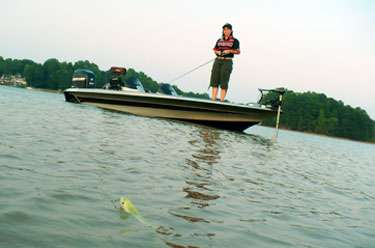
After one look into Michelle Armstrong's rod locker, I knew this Women's Bassmaster Tour pro was not only well-educated, she was also well prepared for battling bass on the surface.
"Summer heat can be extremely tough for anglers," says Armstrong. "However, it is also one of my favorite times of the year for topwater, and that's the main reason I always have a Heddon Zara Spook rigged and ready."
Armstrong constantly keeps an eye open for a sudden surge of surface activity. "When schooling bass push isolated pods of shad to the surface on a feeding frenzy, you don't want to miss the opportunity. You have to react quickly."
To increase her reaction time, Michelle keeps her front deck well organized. One side of her front deck is for her 6 1/2-foot medium-heavy American Eagle Spook rod, paired with a Bass Pro Shops Pro-Elite high-speed baitcaster and spooled with Bass Pro Shops 50-pound-test braided line. The other side holds another American Eagle Rod with her follow-up bait, a Yum Dinger rigged weightless and secured to fluorocarbon line. It's there for bass that miss the Spook.
Most professional bass anglers make modifications to their baits, and this Mercury Outboard pro staffer is no different, except for her terminology.
"I like to refer to my Spook modifications as a 'makeover,'" laughs Armstrong, known on the WBT as "The Nail-Medic." She's a manicurist, when not on the water.
Armstrong's modifications begin with the hooks.
"I have an enormous amount of confidence in the hook-up ratio of Gamakatsu EWG treble hooks," she says. "In fact, all of my hard baits are dressed with them."
To increase her odds of setting those hooks into a bass, she adds an extra split ring (for a total of two) between the hook and the bait.
If your particular Spook has no split ring and is directly attached to the hardware, Michelle suggests cutting off the original packaged hooks and adding split rings paired with Gamakatsu EWG hooks.
"Besides changing the hooks, there are two more makeover changes I feel are imperative to my presentation," Armstrong says. "First, I dress the rear treble hook with a feather, which I feel is critical in my presentation. This gives the Spook a natural, subtle live appearance when motionless on the surface.
"Second, I never tie my bait directly to the braided line; instead I always use a snap, which in turn increases the Spooks side-to-side movement, especially during a 'walk-the-dog' retrieve."
Michelle claims this set-up connects her rod tip directly with the bait, detecting the most subtle and minute movements.
"Due to the limpness of braided line there is a tendency for the line to become tangled in your bait's hooks. I've found that by applying fly-line wax to the first 12-16 inches of braid, your braided line will float, thus eliminating this situation."
Armstrong's Spook inventory is impressive, but she has a couple of favorites.
"My go-to Spooks are typically the Super Spook Jr. and the SwayBack Spook. The baits are different and have different actions, which makes alternating them upon the surface so crucial in enticing bass to hit them."
According to Armstrong, the Super Spook Jr. is a 3.5-inch bait equipped with an internal rattle chamber, while the SwayBack Spook is slightly longer, measuring 4 1/2 inches.
"The banana shape of the SwayBack Spook allows both the nose and the tail to stick out of the water, creating a lifelike silhouette," Armstrong adds. "This position makes for a slightly higher pull point, allowing the SwayBack to walk much easier."
Regardless of which model she is casting, Michelle always utilizes the exact same makeover and presentation.
"The walk-the-dog retrieve incorporates all of the Spook's action when sashaying across the surface."
Michelle holds her rod tip towards the water, twitching it as she reels and causing her Spook to move only a few inches in a side-to-side manner. Michelle cautions anglers not to utilize their reel to move the bait. "Only turn your reel handle to pick-up the slack you have created during the twitching action."
Michelle's final suggestion for adding excitement to your Spook presentation is one that should pay dividends for any basser.
"I actually vary from the traditional walk-the-dog retrieve," she says. "In fact, I call it 'running the dog.'"
By twitching and retrieving her Spook with a very fast cadence, Armstrong has discovered she entices more bites and covers water much quicker.
"I assure you this faster retrieve imparts a much tighter swimming motion, and that has filled my livewell on many occasions."




